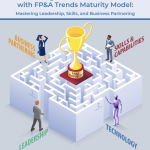In this article, we will explore the impact of digital transformation on FP&A and discuss how...

We all have noticed a huge change in how our businesses operate during the last few years, regardless of the industry. Chief Information Officers (CIOs) are talking about new digital ways of doing business and the utter lack of ready talent in your FP&A teams to manage a new scenario of unforeseen competition.
I am sure that most of us have heard the below comments from senior leadership teams:
- The reports I am getting do not give me actionable data.
- Finance is just being the scorekeeper and cannot influence a business outcome.
- Finance does not understand what is happening in the market and has no business awareness.
- Finance is too slow and provides data that becomes stale by the time it reaches management.
Indeed, FP&A teams are expected to play a crucial role in a company’s digital transformation process since they handle critical financial and operational information across the entire business. It may include sales, operations, supply chain data, and real-time industry and market statistics.
However, in reality, finance and FP&A, in particular, as a function, are not transforming themselves at the same pace as the business in which they are operating. In many cases, we are held back by legacy practices and processes which have largely become irrelevant in the new age.
In this article, I have jotted down a few basic things we did in Japan where we faced the same questions of relevance.
AXA Group Operations Case Study
This transformation journey encompassed three facets – structure, technology, and storytelling.
Structure
We modified the structure of our teams in three aspects.
- The accounting tasks were outsourced to another company.
- We broke the FP&A teams into specialists with domain expertise in reporting, pricing, project management, etc.
- Lastly, we fitted these specialists into our business-facing teams.
We realised that close partnering with our business teams is imperative for the “new normal”, as it can facilitate quick analysis turnaround and decision-making. So, we introduced Finance Business Partners (FBPs) who worked within business teams. They understood the business issues first-hand and solved them by taking the specialists’ help depending on a specific need.
Technology
We also adopted technology. We introduced online dashboards for many areas instead of month-end updates. It meant there was no need for the managers to wait for monthly reports to make decisions. We also invested in scenario-based forecasting tools, tools for doing auto analysis on areas such as Accounts Payable (AP), Accounts Receivable (AR), sales, closing financials, etc. All these were off-the-shelf products, so we did not spend much on customisation. We also introduced several self-service tools, which moved the responsibility of data capturing to the actual people instead of finance doing this work. Lastly, we introduced reporting by exception instead of sending routine reports, which nobody looked at. It helped us release more time for other FP&A activities.
Storytelling
We trained our FP&A guys in storytelling. The training was focused on simple but effective stuff like knowing your audience, anticipating questions in advance, not cluttering slides, avoiding accounting/finance jargon, and always connecting to a corporate strategy. Other key principles introduced were as follows:
- Try to be factual, and don’t present your conclusions.
- Instead, try to get the conclusion from your audience.
Key Lessons Learned
I learnt some important points during our journey, and I feel they may be vital for you as well.
- Make sure that there is full buy-in from the leadership before embarking on this transformation. Otherwise, it will be a disaster.
- The new paradigm requires new skills. That is why hiring people from outside may make sense. Hiring youngsters from colleges is a good option for introducing new technology adoption in a cost-effective manner. If existing people are keen on reinventing themselves, support them in their desire to retrain.
- Set smaller goals through milestones and celebrate them. However, too early celebrations will lead to slack in effort and loss of focus for the longer journey ahead.
- As Eliyahu Goldratt says, “Tell me how you will measure me, and I will tell you how I behave”. Make sure the Key Performance Indicators (KPIs) of all people involved are modified to include incentives for quick and exemplary adoption of the new ways of working.
- I feel that job rotations are very important, especially in finance. It ensures the enrichment of our staff, reduces chances of people getting too comfortable and makes them more fully rounded professionals with a deeper knowledge of their domains rather than just one part of the picture. Do you remember the story of the blind men and the elephant?
- Finally, the transformation leader(s) should make sure that the change is institutionalised. While the change may start as a leader-driven initiative, the team’s DNA will need to be altered to imbibe the spirit and to have it running as an ongoing process. This will ensure that even if the leader moves on for some reason, the spirit and the transformation continue.
In summary
“Predicting rain doesn’t count; building the ark does”
Warren Buffet
While it is impossible to predict the future, we all, as finance leaders, should think of what can happen and ensure that the company is ready to face it successfully.
Subscribe to
FP&A Trends Digest

We will regularly update you on the latest trends and developments in FP&A. Take the opportunity to have articles written by finance thought leaders delivered directly to your inbox; watch compelling webinars; connect with like-minded professionals; and become a part of our global community.






